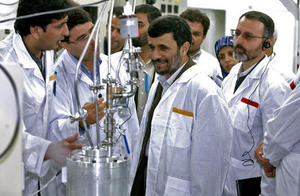Iran's bombUN: Iran accelerates nuclear weapons work, hampers monitoring
Iran has now built up a stockpile of 2,803 kilograms of low-enriched uranium, despite being ordered by the UN to cease all such activity until the IAEA can determine the true nature of Tehran’s nuclear drive; at the end of August, a total 8,856 uranium-enriching centrifuges had been installed at Natanz, up from 8,528 in May; the number of machines being fed with UF6 — uranium hexfluoride — had declined to 3,772 from 3,936, though, owing to on-going technical difficulties (some of which caused by Israeli and U.S. covert sabotage campaign); Iran has now produced at least 22 kilograms of higher-enriched uranium, bringing the Islamic republic closer to levels needed to make the fissile material for a nuclear bomb

Ahmadinijad visiting Natanz enrichment facility // Source: turner.com
Iran’s relentless march toward the bomb continues, accompanied by actions necessary to make such a drive a success: preventing UN inspectors from doing their job, expelling inspectors who try to dig too deeply, breaking IAEA-attached seals on sensitive uranium enrichment equipment, and more.
Iran is hampering a long-running investigation into its drive to acquire nuclear weapons by vetoing the nomination of certain UN inspectors, the UN atomic watchdog said Monday. The International Atomic Energy Agency (IAEA) also said that a number of its seals had been broken on equipment at Iran’s main uranium enrichment plant in Natanz.
AFP reports that in a new restricted report, a copy of which was obtained by AFP, the IAEA complained that the “repeated objection by Iran to the designation of inspectors with experience in Iran’s nuclear fuel cycle and facilities hampers the inspection process.”
Under its safeguards agreement with the agency, Tehran is legally allowed to reject the IAEA’s list of designated inspectors. By actually doing so, however, it “detracts from the agency’s capability to implement effective and efficient safeguards in Iran,” the report said.
Recently, the Islamic republic decided to strip two experienced inspectors of the right to monitor Tehran’s nuclear activities after they reported undeclared nuclear experiments conducted by Tehran.
Vetoing certain inspectors “makes our work more difficult” because new inspectors need time to gain knowledge and experience of Iran’s nuclear program, said a senior diplomat familiar with the IAEA’s Iran investigation.
“But it also adds to pressure on the inspectors. Some may feel unsure, they may fear being kicked out of the country” if the Iranians do not agree with their findings, the diplomat said.
Iran says it barred the two inspectors recently because their reporting was inaccurate. The IAEA, though, stands by their findings and said it had “full confidence in the professionalism and impartiality of the inspectors concerned, as it has in all of its inspectors.”
The IAEA report also said it had asked Iran to explain “a number of incidents involving the breaking of seals by the operator of the FEP (fuel enrichment plant).”
Iran told the agency that the breakages were “accidental,” but UN inspectors would need to conduct a so-called physical inventory verification (PIV) to determine, for example, whether any material or equipment had gone missing and the next PIV was scheduled for October, the report said.
The senior diplomat said such seal breakages could occur accidentally, for example, if equipment is moved.
In this case, there were four such breakages, two of which could be readily explained and verified. The other two still had to be evaluated, the official said, noting that there are “many, many seals in that facility. Iran cannot move anything without us knowing.”
The report estimated that Iran has now built up a stockpile of 2,803 kilograms of low-enriched uranium, despite being ordered by the UN to cease all such activity until the IAEA can determine the true nature of Tehran’s nuclear drive.
Enrichment is at the core of the West’s suspicions about the program because it can be used not only to produce nuclear fuel, but also the fissile material for an atomic bomb.
At the end of August, a total 8,856 uranium-enriching centrifuges had been installed at Natanz, up from 8,528 in May. The number of machines being fed with UF6 (uranium hexfluoride) had declined to 3,772 from 3,936.
The IAEA did not offer a possible explanation for the development. It did say, however, that Iran has now produced at least 22 kilograms of higher-enriched uranium, which Tehran says is for a research reactor.
Iran, which had previously been enriching uranium to levels of no more than 5.0 percent in Natanz, started enriching to close to 20 percent purification in early February, ostensibly to make fuel for a research reactor in Tehran.
The move was in defiance of UN sanctions and drew wide condemnation from Western countries because it brings the Islamic republic closer to levels needed to make the fissile material for a nuclear bomb.
According to the new report, Iran had placed the material in a “cylinder with a capacity of about 25 kilograms (and) this material is under containment and surveillance.”
